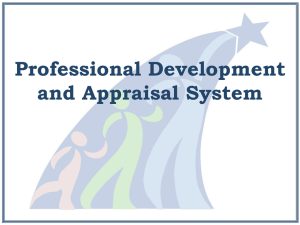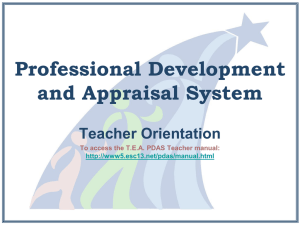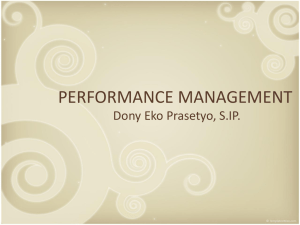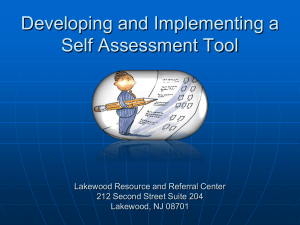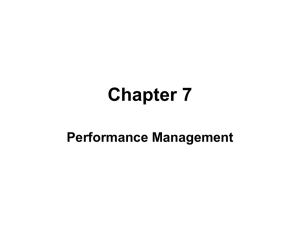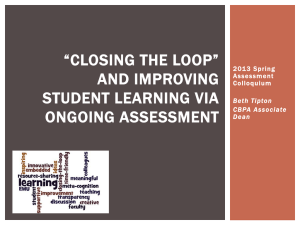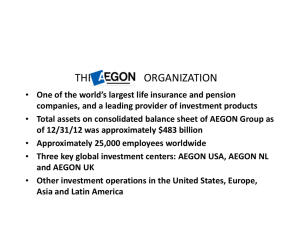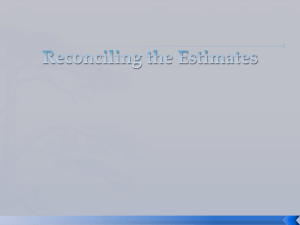PDAS Update Training
advertisement
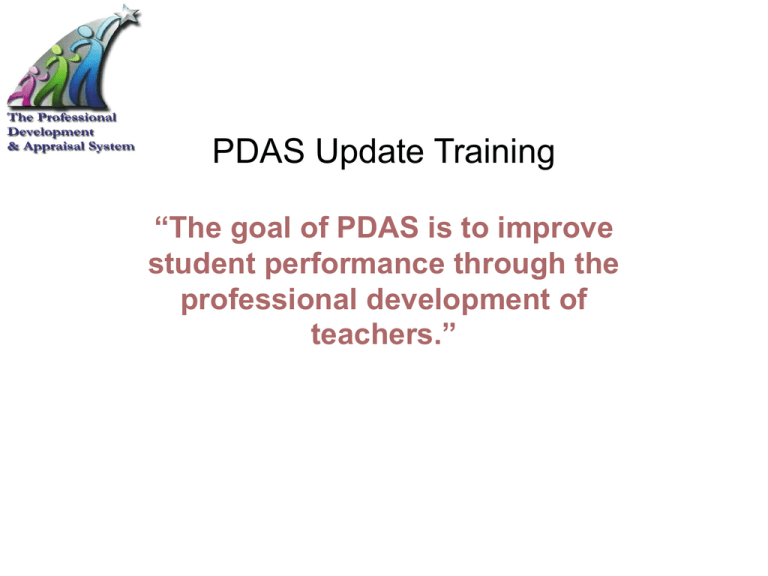
PDAS Update Training “The goal of PDAS is to improve student performance through the professional development of teachers.” Agenda •Timelines •Local Decision •TSR •TINA •Performance Level Decisions APPRAISAL PERIOD TIME LINE SCHOOL CALENDAR YEAR First 12 weeks Second 12 weeks Third 12 weeks Teacher Orientation • Within 1st 3 weeks • Observations no earlier than 3 weeks after Teacher Self-Report-I • No later than three weeks after orientation. TEACHER SELF-REPORT II & III • At least two weeks prior to summative conference Formal Observations •Minimum of 45 minutes or shorter segments •Written summary within 10 working days •Advanced notice may be given/NOT REQUIRED •Follow district APPRAISAL CALENDAR •May have pre or post conference at request of Teacher or Appraiser WALK-THROUGH VISITS •To be used at the discretion of the appraiser •Documentation shared with teacher within 10 days ADDITIONAL TIME LINE ISSUES SUMMATIVE ANNUAL REPORT SUMMATIVE CONFERENCE Teacher Response • 5 working days before conference • Within 10 working days (Appraiser may extend to 15) • No later than 15 working days before last day of instruction • No later than 15 working days before last day of instruction 2nd • May rebut or request appraisal within 10 working days after receiving any documentation • Observation Summary • Walk-through documentation • Third party/Teacher documentation • TSR I, II, III • May be waived in writing by Teacher, NOT APPRAISER. • If Appraiser is not administrator on campus, principal/asst. principal or designated supervisory staff will participate. Last 15 Days of INSTR. Timelines •Orientation •All teachers on campus should receive orientation. •It has to be done within the 1st 3 weeks; it can be before students arrive. •Topics to cover: •Your expectations •Campus/district focus •Duties •Classroom performance •Teacher Self-Report (Parts I, II, and III) •Conferences: pre/post and summative •It should be a Standardized/uniform/consistent message to all of your teachers. Timelines •Teacher Self-Report •Part I is due within 3 weeks of the orientation. •Parts II and III are due at least 2 weeks before the summative conference. •Walkthroughs •Should begin the first day of instruction and continue through the final day of instruction. •Formal observations •Earlier is better. •Completing observations and conferences in the fall can direct professional development for rest of year. Timelines •Locally Adopted Calendar •Know your local calendar; it should be covered in staff orientation. •Follow your local calendar. •Documentation •Teachers must be notified within 10 days of you receiving information that will affect their appraisal. •When documenting it is best to document the date received and the date of teacher notification. Timelines •Summative Conference •Give yourself a buffer; complete all summatives well before the deadline. •Earlier is better, especially in cases where a 2nd appraisal is requested. •There should not be any surprises in the summative conference. Timelines •What if you fail to follow any part of the timeline? •The PDAS system has two main goals: professional development and appraisal. Teachers and appraisers are encouraged to complete the appraisal process, even when timelines are broken, because the system can still contribute to professional development, especially through completion of the Teacher Self-Report (TSR) and the annual summative appraisal. However, when timelines are not adhered to, the appraisal cannot be used for employment decisions. Local Decisions •Local Policy •Board must approve •Appraisal policy •Local calendar •2nd appraisal process •Grievance policy •All appraisers in district Local Decisions •Who should be appraised using PDAS? •PDAS was designed to evaluate classroom teachers. Other education professionals must be evaluated annually; however, they do not have to be evaluated with PDAS. A district may develop an appraisal system for these educators or modify other systems so long as the job requirements of that group are addressed. If the educator is the teacher of record for at least one class they must be appraised using PDAS or a locally developed teacher appraisal. Local Decisions •What is a teacher’s recourse if he/she does not agree with his/her appraisal? •Within 10 working days after receiving an Observations Summary or a Summative Annual Appraisal a teacher has two options if he/she does not agree with the report. •A written response or rebuttal may be submitted which becomes a part of the teacher’s appraisal; or •A 2nd observation can be requested in writing. Local Decisions •2nd appraisals •How are 2nd appraisals initiated and weighted with the initial appraisal in your district? This will be in your district’s local appraisal policy. •The following will be included in the 2nd appraisal: a 45 minute observation (or equivalent amount of time in shorter segments), scoring of all domains, cumulative documentation collected by the first appraiser, particularly in Domains VI, VII, and VIII, and any walk-through documentation that are used to score any or all domains. Teacher Self-Report • • • Gives the teacher an opportunity to have input into his/her appraisal process. Serves as a platform to align instruction. Is a reflective tool. Teacher Self-Report •TSR I •The Texas Essential Knowledge and Skills (TEKS) objectives listed in Section I of the TSR are skills embedded in all learning. All grades and subjects teach or reinforce some of all of these skills within the context of the respective curriculum and at the appropriate level for the assigned students. •It can be revised during the school year as needed. This must be done at least 2 weeks prior to the Summative Annual Conference. Teacher Self-Report • • Parts II and III of the TSR give the teacher an opportunity to give his/her appraiser additional information about his/her efforts to improve the students’ performance. TSR Parts II and III should connect to the Campus Improvement Plan and this should be communicated to the teachers during orientation. Teacher Self-Report •The appraiser should use the TSR as one piece of the data in completing the Summative Annual Appraisal. •The TSR should also help to drive all of the appraisal conferences, especially the summative conference. Teacher In Need of Assistance •When do you use a TINA? •Commissioner’s Rules 150.1004 (a) (1) a teacher who is evaluated as unsatisfactory in one or more domains; or (2) a teacher who is evaluated as below expectations in two or more domains. •TINA’s can also be developed for a teacher at the discretion of the appraiser when the appraiser has evidence that would potentially produce an evaluation rating of below expectations or unsatisfactory. Teacher In Need of Assistance •Documentation needs to include the following: •Date: Date of occurrence, date of notification of the teacher •Facts (who, what, when, where) •Explicit (as it relates to language used in the PDAS framework) •Behavior observed •Valid source (must be verified when data is coming form a 3rd party) Teacher In Need of Assistance •Development of the TINA must include: •A partnership between the teacher and appraiser. •Focus on the Domain(s) that designate the teacher as a Teacher In Need of Assistance. •Professional Development activities and dates for completion. •Evidence that will be used to determine that professional development activities have been completed. •Directives for changes in teacher behavior and timelines. •Evidence that will be used to determine if teacher behavior has changed. Teacher In Need of Assistance •When a teacher needs to be placed on a TINA, earlier is better. •Get it started as early as possible to give opportunity for growth. •At the first sign that there might be a problem, get involved. Teacher In Need of Assistance •When developing the intervention plan it shall: •include options for professional development activities designed to enhance teacher proficiency. •At least one option shall not place significant financial burden on either the teacher or the school district. Performance Level Decisions •Communicating Expectations •Needs to happen when teachers report through their final work day. •Constant, clear, concise. •Two-way, get teachers’ input. Performance Level Decisions •Pre and Post conferences •Pre- should be two way and used to communicate expectations of the appraiser and teacher. •Post- should be used for feedback, growth, and planning. •Every teacher should be given both pre and post conferences, the more communication the better. Performance Level Decisions •Proficient Standard is defined under PDAS as: •The four performance levels under PDAS (Exceeds Expectations, Proficient, Below Expectations, and Unsatisfactory) are defined in terms of the impact on student learning. In other words, what is the impact on student learning and how often and with how many students does the positive impact on learning occur? Since the goal of PDAS is to enhance the learning of all students, the “proficient” level is a high standard of performance. Teaching behaviors that result in considerable impact on student learning and which are demonstrated a high percentage of the time and with a high percentage of students (80-89%) is ‘proficient.’ Words associated with ‘proficient’ teaching behaviors or the rating of ‘proficient’ are: skillful, experienced, masterful, well-advanced, and knowledgeable. Performance Level Decisions •Using inference is acceptable in the following cases: •It can be applied to Domains I, II, III, IV, V, VII, and VIII (except Criteria 10). •You can infer proficient in only one criteria out of a domain if 80% of the other criteria in the domain are proficient or better. •All of Domain VII can be inferred if there is no evidence otherwise. •None of Domain VI can be inferred. Performance Level Decisions • Decisions should be based on: • • • Critical Attributes Quality Quantity Performance Level Decisions •Quality Scoring Standards •S trength •I mpact •V ariety •A lignment Performance Level Decisions •Strength •Thinking at high cognitive levels •Depth & Complexity •Significant Content •Connecting within/across disciplines & work/life applications •Effective, clear & substantive Performance Level Decisions •Impact •Promotes student success •Effective use of assessments •Data-driven decision making •Responsibility •Reflection •Challenging Performance Level Decisions •Variety •Varied student characteristics •Differentiated instruction •Support strategies & services Performance Level Decisions •Alignment •Curriculum, instruction and assessment aligned with TEKS & district objectives •Targeted instruction •Congruent Performance Level Decisions •Quantity •Can you see it? •Did it happen? •How often? •How many students? Closure
